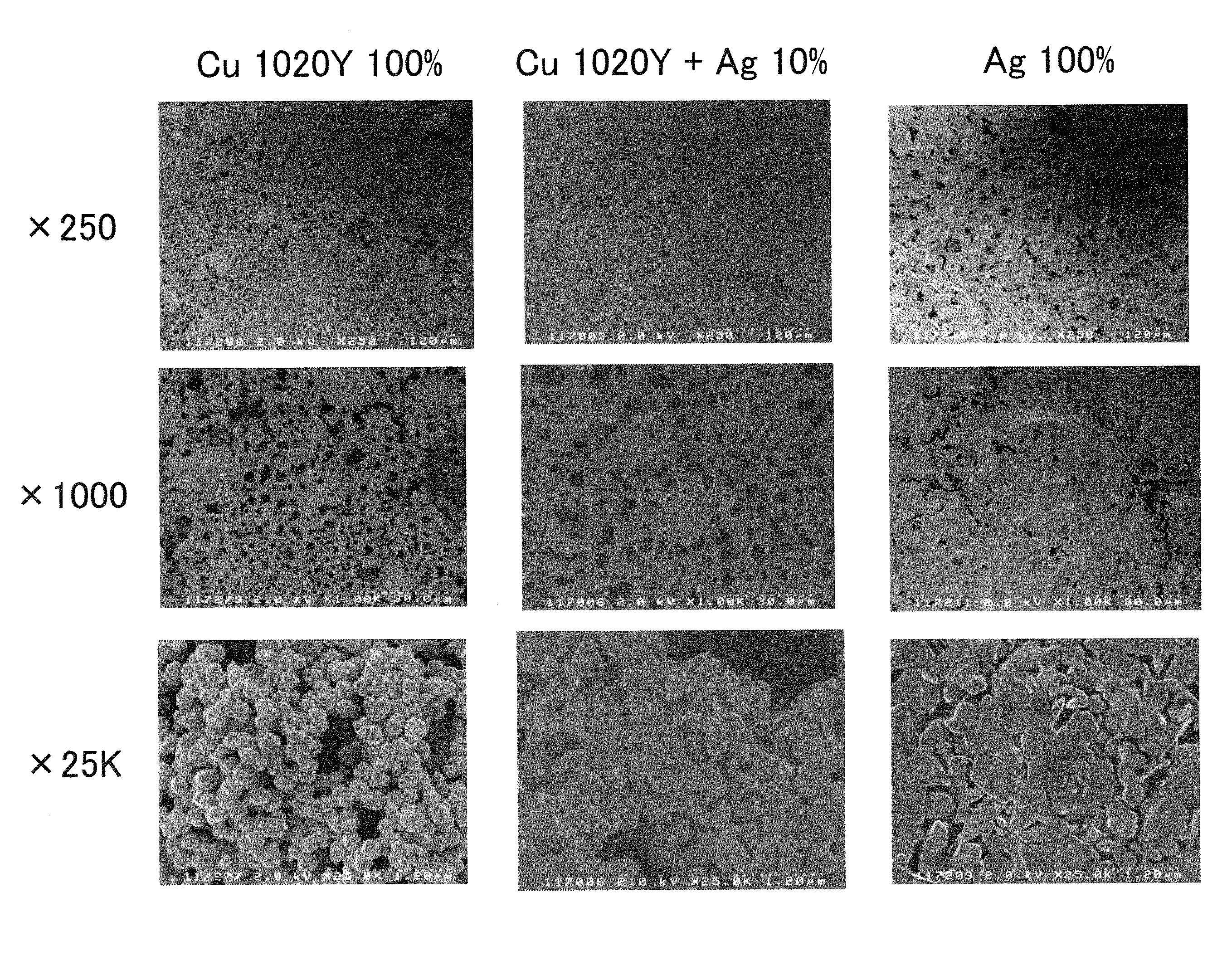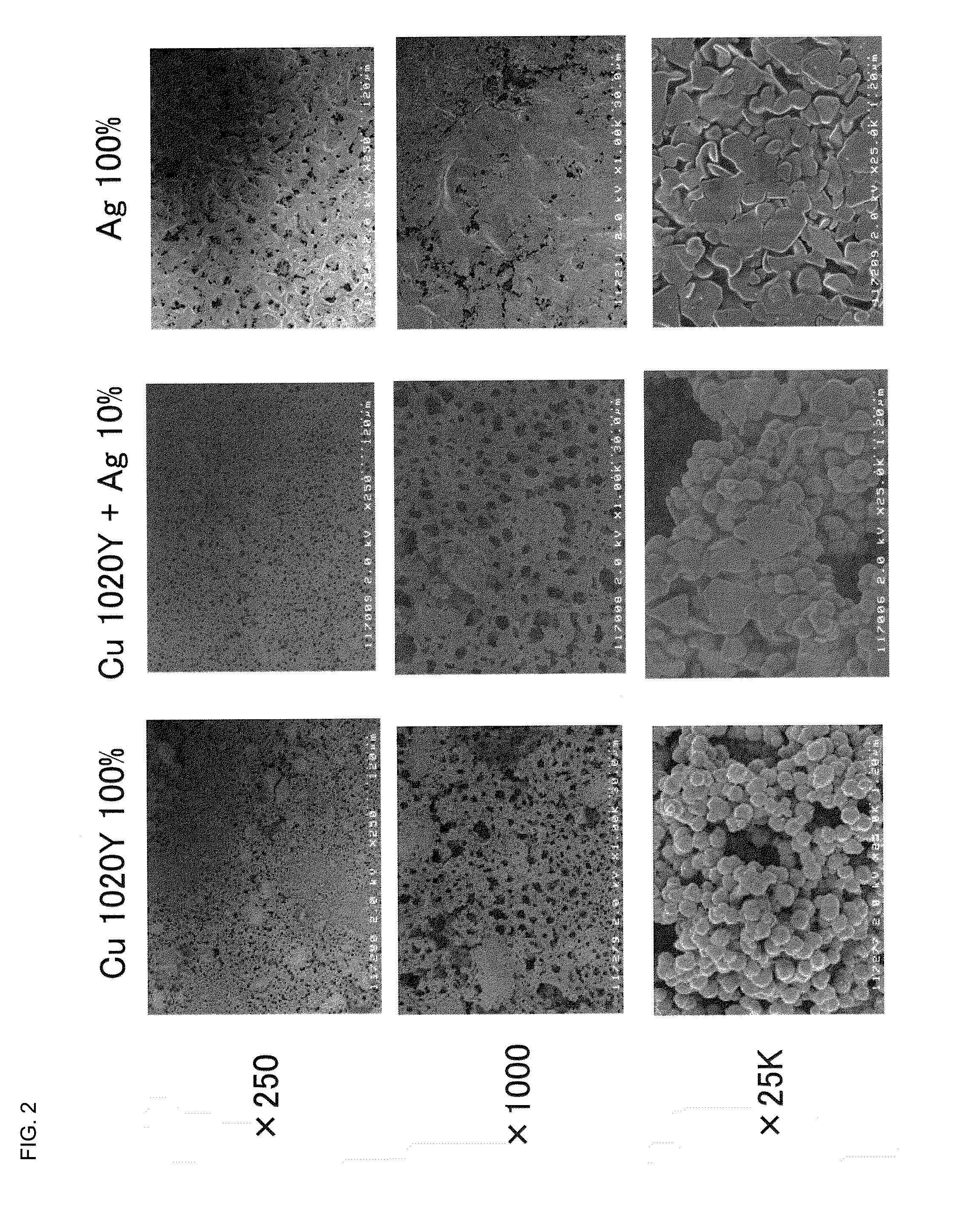Conductive pattern formation method and composition for forming conductive pattern via photo irradiation or microwave heating
- Summary
- Abstract
- Description
- Claims
- Application Information
AI Technical Summary
Benefits of technology
Problems solved by technology
Method used
Image
Examples
example 1
[0051]Polyvinylpyrrolidone (made by Nippon Shokubai Co., Ltd.) as a binder was dissolved into a mixed aqueous solution of ethyleneglycol and glycerin (a reagent made by Kanto Chemical Co., Inc.) as a reducing agent to prepare a binder solution of 40 mass %. A mass ratio of ethyleneglycol and glycerin and water in the mixed aqueous solution is 70:15:15. Then, 1.5 g of this solution was mixed with 0.5 g of the above mentioned mixed aqueous solution, into which 5.4 g of copper powder 1050Y (spherical, D50=716 nm) made by Mitsui Mining and Smelting Co., Ltd. and 0.6 g of N300 as silver particles (flat (thickness: 30 nm), D50=470 nm) made by Tokusen Co., Ltd. were mixed (copper particles:silver particles=90:10), and well mixed using Planetary Centrifugal Vacuum Mixer “Thinky Mixer” (AWATORI RENTAROU) ARV-310 (manufactured by Thinky Corporation) to prepare a paste for printing (composition for forming a conductive pattern).
[0052]The obtained paste was printed on a polyimide film (Kapton 1...
example 2
[0053]5.4 g of copper powder 1100Y made by Mitsui Mining & Smelting Co., Ltd. (spherical, D50=1110 nm) and 0.6 g of N300 as silver particles (flat (thickness: 30 nm), D50=470 nm) made by Tokusen Co., Ltd. were used to prepare a paste for printing in the same manner as that in Example 1. The obtained paste was printed in a pattern in the same manner as that in Example 1, and subjected to photo irradiation. The thickness of the conductive pattern formed was 23 μm.
example 3
[0054]5.4 g of copper powder 1400Y made by Mitsui Mining & Smelting Co., Ltd. (spherical, D50=5700 nm) and 0.6 g of N300 as silver particles (flat (thickness: 30 nm), D50=470 nm) made by Tokusen Co., Ltd. were used to prepare a paste for printing in the same manner as that in Example 1. The obtained paste was printed in a pattern in the same manner as that in Example 1, and subjected to photo irradiation. The thickness of the conductive pattern formed was 26 μm.
PUM
| Property | Measurement | Unit |
|---|---|---|
| Thickness | aaaaa | aaaaa |
| Thickness | aaaaa | aaaaa |
| Nanoscale particle size | aaaaa | aaaaa |
Abstract
Description
Claims
Application Information
 Login to View More
Login to View More - R&D
- Intellectual Property
- Life Sciences
- Materials
- Tech Scout
- Unparalleled Data Quality
- Higher Quality Content
- 60% Fewer Hallucinations
Browse by: Latest US Patents, China's latest patents, Technical Efficacy Thesaurus, Application Domain, Technology Topic, Popular Technical Reports.
© 2025 PatSnap. All rights reserved.Legal|Privacy policy|Modern Slavery Act Transparency Statement|Sitemap|About US| Contact US: help@patsnap.com



